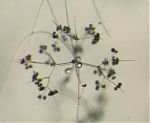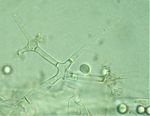Chaetocladium
CHAETOCLADIUM Fresenius, 1863 (Beitr. Mykol., p. 97); 2 spp. (Benny and Benjamin, 1976—monograph).
Chaetocladium (Benny and Benjamin,1976) produces unispored sporangia with separable spore and sporangial walls. The sporangia have a discoid columella and they are borne on a pedicel that arises from a vesicle that can be more or less sessile or even stipitate. The fertile hyphae are formed in pairs or three branches arise from the same point. The branches often terminate in a sterile spine. Zygospores have opposed suspensors that are either more or less equal or heterogamous. Both species are facultative parasites of other Mucorales.
Type species: C. jonesii
Species of Chaetocladium:
C. brefeldii van Tieghem & Le Monnier, 1873 (Ann. Sci. Nat, Bot., Sér. V, 17:342).
C. jonesii (Berkeley & Broome) Fresenius, 1863 (_Beiträge zur Mykologie_, p. 98).
In nature these fungi are facultative, gall-forming parasites of other Mucorales. Chaetocladium spp. grow well on many culture media in the laboratory. Chaetocladium brefeldii, and presumably C. jonesii, can be found in the winter parasitizing other Mucorales in warmer regions of the United States. Chaetocladium has been studied by Hesseltine and Anderson (1957), and Benny and Benjamin (1976). I never observed zygospores during my study of Chaetocladium jonesii but they were illustrated by Brefeld (1881—as Chaetocladium fresenianum). Burgeff (1920) studied parasitism and gall formation in Chaetocladium. The genus has been reported from India (Singh, 1968) and Japan (Mikawa, 1979).
Both species grow best below 20 C; the zygospores are produced below 20 C. Mil’ko and Beljakova, 1967, 1971), and Mil’ko (1974) treated Thamnocephalis (Sigmoideomycetaceae, Zoopagales) as a synonym of Chaetocladium. Mil’ko (1974) included Chaetocladium in the Cunninghamellaceae.
Bibliography
Benny, G.L., and R.K. Benjamin. 1976. Observations on Thamnidiaceae (Mucorales). II. Chaetocladium, Cokeromyces, Mycotypha, and Phascolomyces. Aliso 8:391-424.
Brefeld, O. 1881. Chaetocladium fresenianum, pp. 55-59. In: O. Brefeld. Botanische Untersuchungen über Schimmelpilze. Vol. 4. Verlag von Arthur Felix, Leipzig, Germany.
Burgeff, H. 1920. Ãœber den Parasitismus des Chaetocladium und die heterokaryotische Natur von ihm auf Mucorineen erzeugten Gallen. Zeit. Bot. 12:1-35.
Hesseltine, C.W., and P. Anderson. 1957. Two genera of molds with low temperature growth requirements. Bull. Torrey Bot. Club 84:31-45.
Mikawa, T. 1979. A taxonomic study on Japanese sporangiferous Mucorales (3). J. Japan. Bot. 54:78-85.
Mil’ko, A.A. 1974. Opredeltiel’ mukoral’nykh gribov [ Key to the identification of Mucorales ]. ‘Naukova Dumka’ , Kiev, Ukraine. 303 p.
Mil’ko, A.A., and L.A. Beljakova. 1967. Rod Cunninghamella Matruchot I taxonomie Cunninghamellaceae [Genus Cunninghamella Matruchot and taxonomy of the Cunninghamellaceae]. Mikrobiologiya 36:684-690 [English translation available in Microbiology 36 (4):573-578, 1967].
Mil’ko, A.A., and L.A. Beljakova. 1970. The genus Choanephora Currey (Mucorales). Mikrobiologiya 38:894-902 [English translation available in Mikrobiologiya 38:864-770]).
Singh, S.N. 1968. Chaetocladium brefeldii van Tieghem from India. Sydowia 20:329-330.
Updated Mar 14, 2005


